
Transit Briefs: DART, Metro-North, NJT, TriMet
Written by Marybeth Luczak, Executive Editor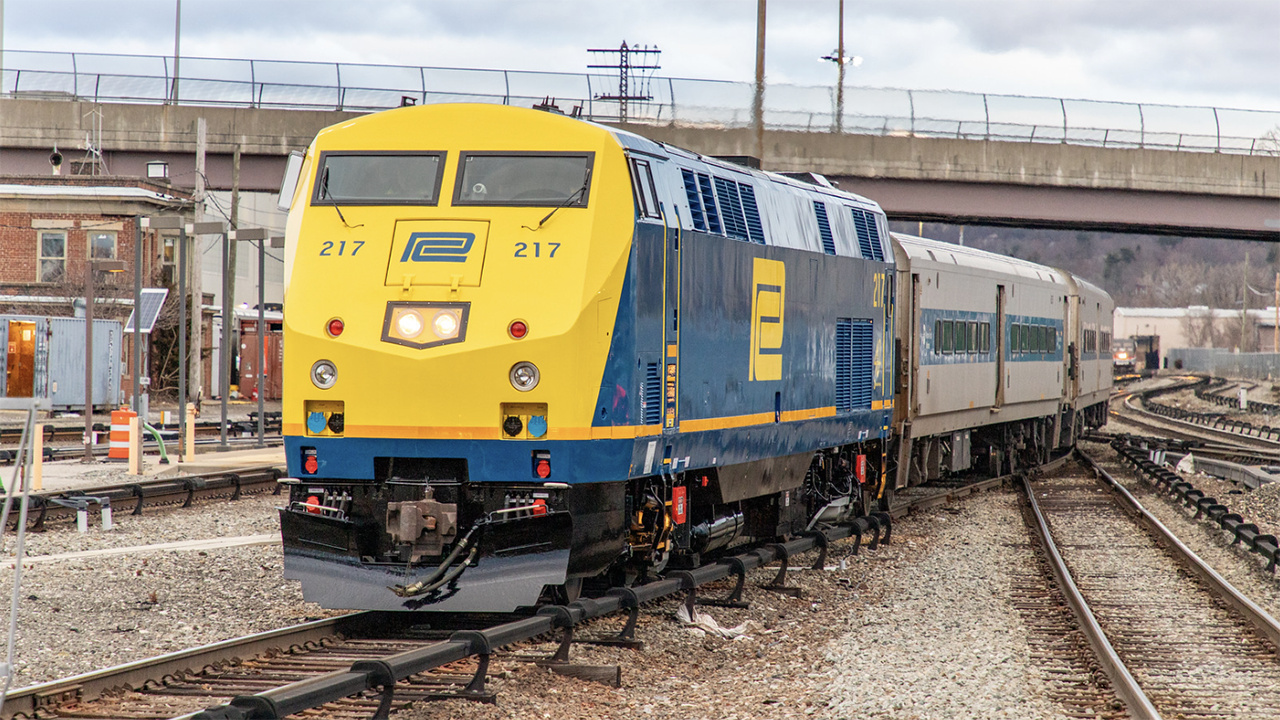
Pictured: Metro-North Railroad’s “Penn Central” heritage locomotive’s inaugural run. (MTA Metro-North Railroad Photograph)
Dallas Area Rapid Transit (DART) offers a sneak peek of its new LRV seats. Also, MTA Metro-North Railroad debuts its fourth heritage locomotive; New Jersey Transit (NJT) advances a mixed-use, multi-phase Transit-Oriented Development (TOD) project near Hoboken Terminal, where it is also working on resiliency upgrades; and Tri-County Metropolitan Transportation District of Oregon (TriMet) proposes a $1.75 billion budget for Fiscal Year (FY) 2025.
DART
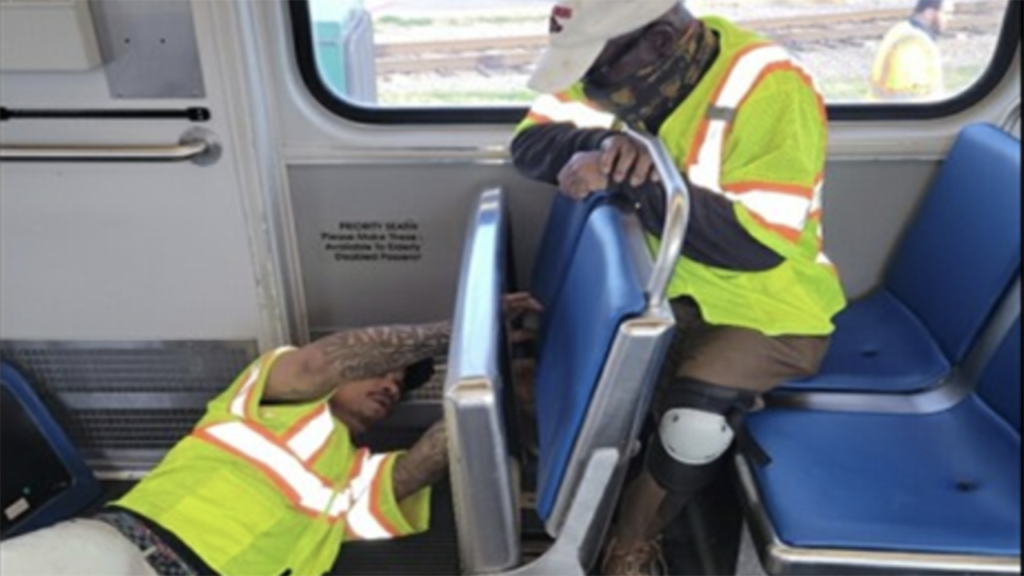
DART has upgraded rider seating on more than 20 light rail vehicles (LRV), which are now rotating between service on the Orange, Green, Red and Blue lines. The transit agency has been retrofitting seating with new padding and a vinyl finish, which it said is “sleeker, softer and easier to clean.” The first upgraded LRV went into service in January.
The LRV seating upgrade plan was announced last year and covers the refurbishment of more than 16,000 seats, including spare ones created for inventory replacement. In total, the seating on 163 of the oldest LRVs—including 95 that have been in service for 20-plus years—will have the old cloth seats replaced with premium vinyl, DART said. By March 31, DART projects to have more than 40 LRVs retrofitted and in operation, and by June the entire fleet of older LRVs will be in service with refurbished seats.
“One of the biggest things we learned coming out of the pandemic was the need to have surfaces that are easy to clean and sanitize,” said Darryl E. Spencer, DART Vice President of Engineering and Technical Services Development. “These new seats will allow us to provide a cleaner, safer and more comfortable ride as we continue to modernize our system.”
According to DART, the new seats are a big hit with riders so far, with 90% of those taking an available in-vehicle survey saying they preferred the new vinyl seats to the fabric ones and 95% claiming the seats “felt cleaner and more hygienic.” Riders can take the survey and provide DART feedback by scanning the QR code found on the seatbacks of the upgraded LRVs.
MTA Metro-North
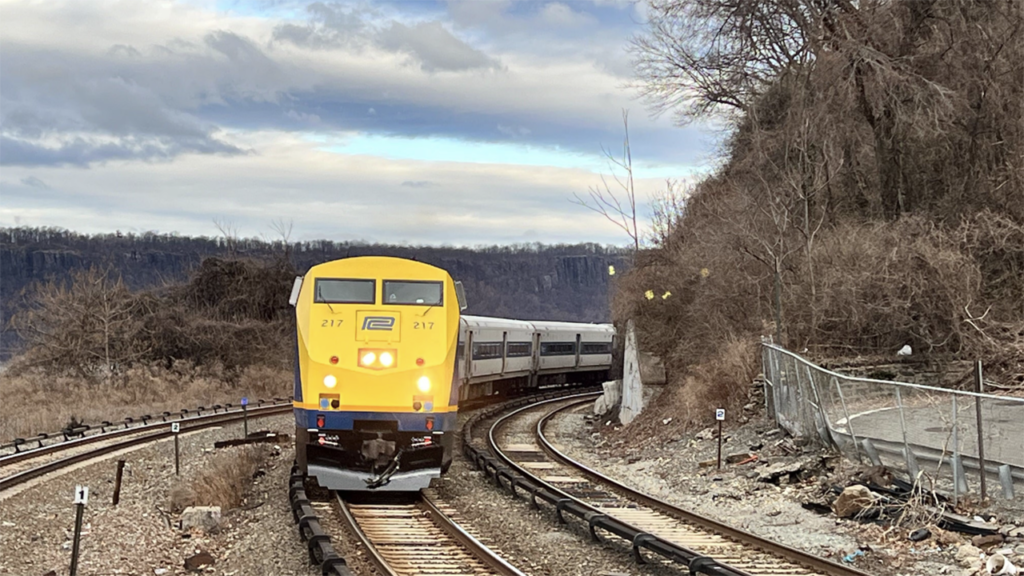
MTA Metro-North is celebrating 40 years of commuter rail service in New York and Connecticut with a series of heritage locomotives honoring its predecessors. For its newest unit—the fourth of five planned—craft workers at the railroad’s North White Plains Shop applied a vinyl wrap to locomotive No. 217, paying tribute to the Penn Central Railroad Corporation. It features Penn Central’s “mating worms” logo. The unit made its debut on the Hudson Line on March 11, departing Croton-Harmon station at 7:58 a.m. and arriving at Grand Central Terminal at 8:55 a.m. (see map below).
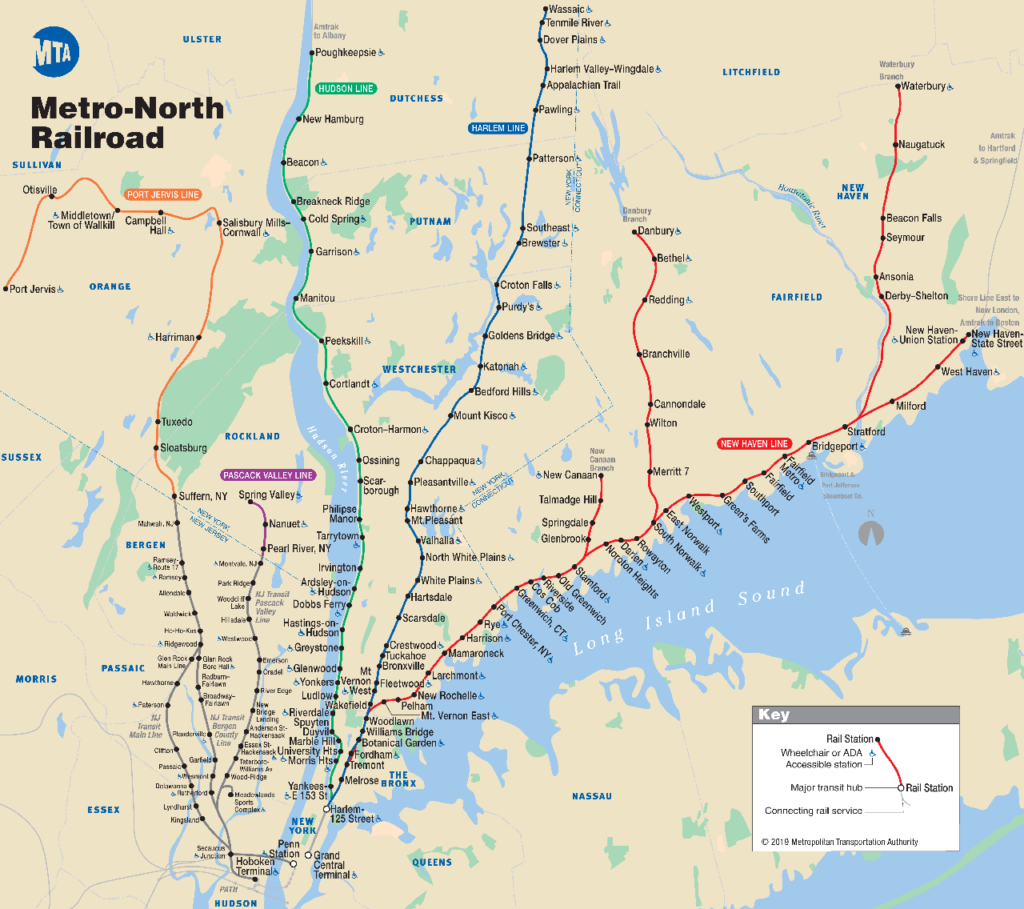
In spring 1970, Metropolitan Transportation Authority (MTA) signed an agreement with Penn Central Railroad Corporation to subsidize the operations of the Hudson, Harlem and New Haven commuter rail lines that would later become the core lines of Metro-North in 1983. One of the stipulations of the subsidy agreement was that the Penn Central would rehabilitate some of its equipment and repaint it in the colors of New York state—a bright yellow and medium blue colors, according to Metro-North. FL9 locomotives 5014 and 5050 were the first two units painted in this scheme, and they were put into service on train 912 from Brewster to Grand Central Terminal on July 28, 1970. In addition to the freshly painted locomotives, a complete set of refurbished coaches filled out the consist for this inaugural run. This paint scheme could be seen on many of Penn Central’s FL9s from 1970 until the start of Conrail operations on April 1, 1976.
“Every new wrapped locomotive reminds us of the incredible history of rail travel in the region that preceded the formation of Metro-North Railroad,” Metro-North Railroad President Catherine Rinaldi said. “These wraps give rail enthusiasts and everyone who uses Metro-North every day an opportunity to step back in time as they travel down the scenic Hudson River.”
The first heritage unit was locomotive No. 208, which made its debut in May 2023 with a vinyl wrap of silver, blue and red to pay homage to Metro-North’s original design. The design was created for the FL9s upon the railroad’s founding in 1983 and used until the last unit was retired in April 2007.
The second heritage unit paid tribute to Conrail, which is Metro-North’s immediate predecessor. The unit was introduced on the Hudson Line on Aug. 14, 2023. The design of the wrap mimics the paint scheme applied to older FL9s that Conrail operated for MTA over the Hudson, Harlem and New Haven lines from 1976-1982. Metro-North’s locomotive No. 201 is one of 31 P32ACDM models the railroad uses to provide service on the northern Hudson and Harlem lines and the New Haven Line’s Danbury and Waterbury branches.
The third heritage locomotive paid tribute to New York Central, the predecessor railroad that operated on the Hudson and Harlem lines. Metro-North’s locomotive No. 211 made its debut on the Hudson Line on Nov. 14, 2023.
NJT
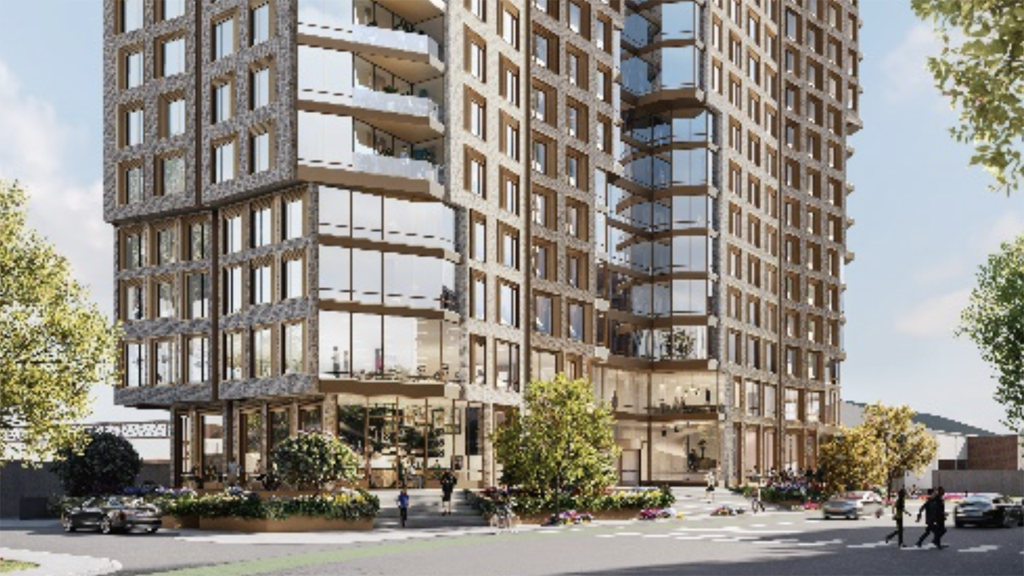
NJT’s Board of Directors on March 12 approved a ground lease agreement with LCOR Hoboken Rail Station Redevelopment, LLC for Hoboken Connect, a TOD project near the Hoboken Terminal, which is served by eight NJT commuter rail lines in addition to NJT bus and private carrier bus routes, Hudson–Bergen Light Rail, Port Authority Trans Hudson (PATH) rapid transit, and New York Waterway-operated ferries.
The project is a multi-phased initiative that will comprise mixed-use development and public infrastructure improvements to the Hoboken Bus Terminal, Ferry Terminal Building and the area surrounding the rail station. These components, NJT said, will be implemented over the next several years.
The three proposed project phases will directly and indirectly support 5,840 jobs during construction and support an estimated 7,265 jobs at full build-out, according to the transit agency, which noted that the economic impact is estimated at more than $2.08 billion annually at full build-out, with more than $1.0 billion estimated in annual payroll. Among the project benefits for NJT: “non-farebox revenue ground lease payments, increased ridership, and customer experience improvements.”
The private investment phase includes a mixed-use residential building consisting of 386 apartments (20% classified as affordable housing), which will be facilitated by the newly approved ground lease, a 20-story Class A office building with a rooftop terrace, 5,000 square feet of retail space and related public open space investments, including additional pedestrian, vehicular, and bicycle improvements.
Public investments will include construction of a new bus terminal on Hudson Place, rehabilitation of the first and second floors of the Ferry Terminal Building for commercial and exhibition space, redevelopment of Warrington Plaza, and improvements to Hudson Place to support bicycle and pedestrian access to the transportation facilities. New Jersey Gov. Phil Murphy committed $176 million in the FY 2023 state budget for the public improvement phase, which is advancing in parallel to the private components of the project, according to NJT.
“The Ground Lease Agreement approved by our Board today [March 12] sets the stage for an official ‘Hoboken Connect’ groundbreaking in the coming months, launching a project that will transform our Hoboken Terminal and its surroundings into one of the crown jewels of our system,” NJT President and CEO Kevin S. Corbett said. “This project is one of several examples of our broader TOD strategy to both generating additional non-farebox revenues as well as driving sustainable growth through enhanced public transportation access throughout New Jersey.”
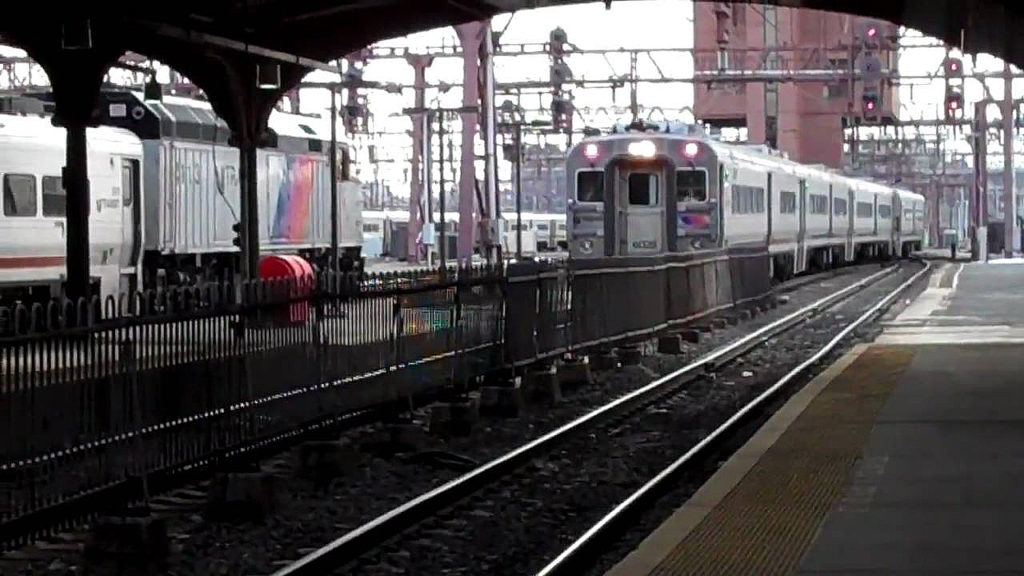
Meanwhile, NJT said it continues advancing “major resiliency upgrades” at Hoboken Terminal as part of Phase 2 of the Long Slip Fill and Rail Enhancement Project. The transit agency’s Board on March 12 approved a contract for the construction of six new tracks, three ADA-accessible high-level platforms, and a new passenger/rail personnel facility. A separate contract was also approved for special trackwork.
The Long Slip Fill and Rail Enhancement Project area is located within the Hoboken Rail Yard along the Hudson River Waterfront near the boundary of southern Hoboken and northeastern Jersey City. NJT was awarded a Federal Transit Administration competitive resiliency grant for the project to provide flood protection, surge protection for rail yard equipment and infrastructure, and flood resilient commuter tracks and platforms.
“Superstorm Sandy had a devastating impact on vulnerable areas of the transit system,” NJT said. “The storm’s aftermath taught lessons on how critical it is to rebuild infrastructure with resiliency firmly in mind. The Long Slip project will mean future storms will do far less damage. It also provides the opportunity to construct new ADA-accessible rail platforms well above surge levels that adds greater capacity at Hoboken Terminal, and further ensures the integrity of the transportation network following extreme weather events.”
Phase 1 of the project—completed in June 2023—extended the municipal sewer that permitted the former canal to be filled in. Phase 2 calls for the construction of new tracks, a new station area with ADA-accessible high-level boarding platforms, and a new passenger/rail personnel facility on what was the former waterway. The new tracks and platforms, with higher elevation, “will better protect the terminal and improve NJT’s ability to continue operating rail service through extreme weather events,” according to the transit agency.
The Board action authorized NJT to enter into a contract with Schiavone Construction Co., LLC of Secaucus, N.J. The contract is valued at $211.13 million, plus 10% for contingencies, for Phase 2 of construction services.
Additionally, the Board approved a separate contract with voestalpine Railway Systems Nortrak, LLC of Birmingham, Ala., for the purchase of special trackwork in the amount of $1.898 million plus 5% for contingencies. This special trackwork, which is also part of Phase 2 of the project, comprises five wood timber turnouts, four concrete crosstie turnouts, one wood timber crossover, and one wood timber double slip switch, totaling 11 individual special trackwork packages, NJT reported.
“The approval of Phase 2 for this project marks a significant step forward in our ongoing efforts to significantly improve resiliency, accessibility and the customer experience at Hoboken Terminal,” Kevin S. Corbett said. “This vital project not only enhances the experience at one of the tri-state region’s busiest intermodal transit hubs, but it supports our broader resiliency strategy by fortifying our network against the impacts of extreme weather events.”
Separately, NJT has expanded its partnership with Comcast Business.
TriMet
TriMet on March 13 released its proposed $1.75 billion budget for FY 2025 (see above), beginning July 1, 2024, and running through June 30, 2025. The transit agency, which offers MAX light rail, WES commuter rail, bus, and paratransit services, said the budget “provides the financial framework to grow ridership, improve the customer experience, and add service, as staffing allows.” It includes nearly $849 million for daily operations; $201 million for capital investments; about $58 million in pass-through and contingency funds; and $642 million in ending fund balance totals, which are unappropriated and unavailable for spending in FY25.
About 91% of funding for FY25 operating resources comes from three sources: payroll tax revenues, passenger revenues and federal funds, TriMet reported. For FY25, the agency expects to receive about $540 million in payroll taxes, $62 million in passenger fares, and about $139 million from federal operating grants. It also receives a small portion of its funding from accessible transportation and service contracts and advertising. The FY25 budget includes the first full year of revenues from TriMet’s 2024 fare increase.
In addition to continuing to run a network of buses and trains across its 533-square mile service district, TriMet in FY25 would like to:
- Add four new Frequent Service bus lines.
- Add new bus lines in East Portland, Sellwood and West Linn.
- Extend service in East Multnomah County and I-205 between Tualatin and Oregon City.
- Add more buses to well-used lines that do not currently have Frequent Service.
- Continue to streamline routes and discontinue service with less ridership and demand.
To support this, the hiring and training additional operators and maintenance staff will continue to be important in FY25, Tri-Met said, as will efforts to increase retention of both new and long-time employees.
The FY25 budget also includes more resources for ongoing spot cleaning, deep cleaning, graffiti cleanup and aesthetic repairs that make the system “feel more desirable and welcoming overall” the agency said.
The proposed safety and security budget for FY25 is quadruple what it was in FY22, according to TriMet. The agency said it has more than doubled the number of security personnel in the past year, as it continues “to adopt a comprehensive and layered approach to safety and security.” Today, there are more than 350 unarmed security personnel providing presence, assistance and resources to riders. In addition to the increased presence on board trains and buses and across the transit system, TriMet said it has established a Safety Operations Center, which helps coordinate response to non-emergency security concerns that occur on the system.
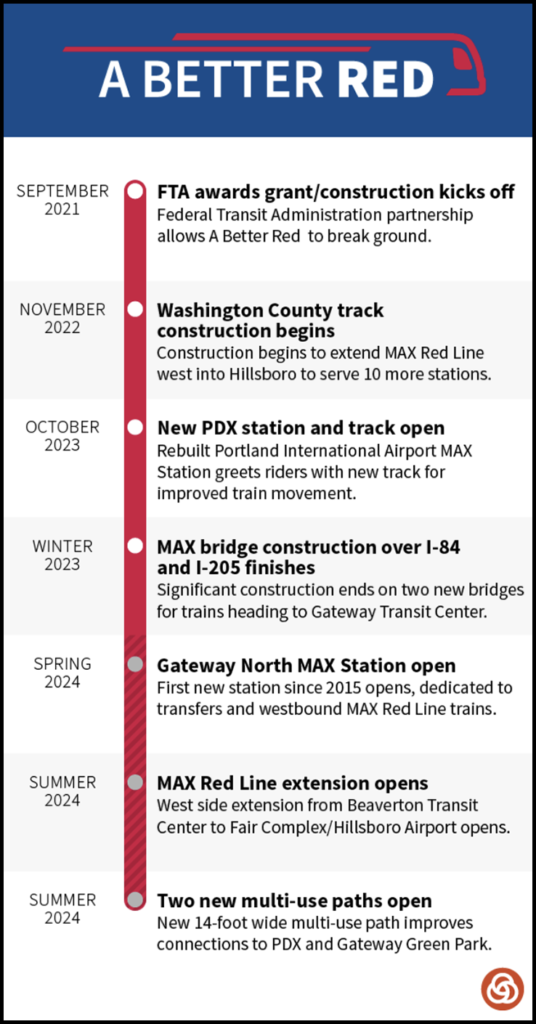
TriMet’s capital projects include the completion this August of A Better Red, which will improve train movement at key sections of the system near Portland International Airport and Gateway Transit Center, and extend the MAX Red Line an additional 10 stations into Hillsboro, helping to provide more capacity in a growing job center of Washington County. TriMet is also replacing its oldest light rail vehicles with new Type 6 models, expanding the SE Park Avenue Park & Ride, and developing its Columbia Operations Facility for testing and expansion of the Zero-Emissions Bus Program.
In response to global warming and the ongoing climate crisis, TriMet said it is continuing the transition to a zero-emissions bus fleet, with the expansion of electric bus charging infrastructure at the Merlo and Powell Operations facilities. The agency currently has battery-electric buses (BEBs) arriving from its first bulk purchase of 24. When delivery is complete, it will have 34 BEBs operating throughout its system, making up about 5% of the total bus fleet. In FY25, TriMet said it will continue “to build capacity for our goal to transition to a full zero-emissions fixed-route fleet by 2040.”
The Board is scheduled to consider adopting the budget at its May meeting. TriMet must adopt a final budget by July 1 to stay in compliance with Oregon Budget Law and to begin spending funds allocated for FY25.


